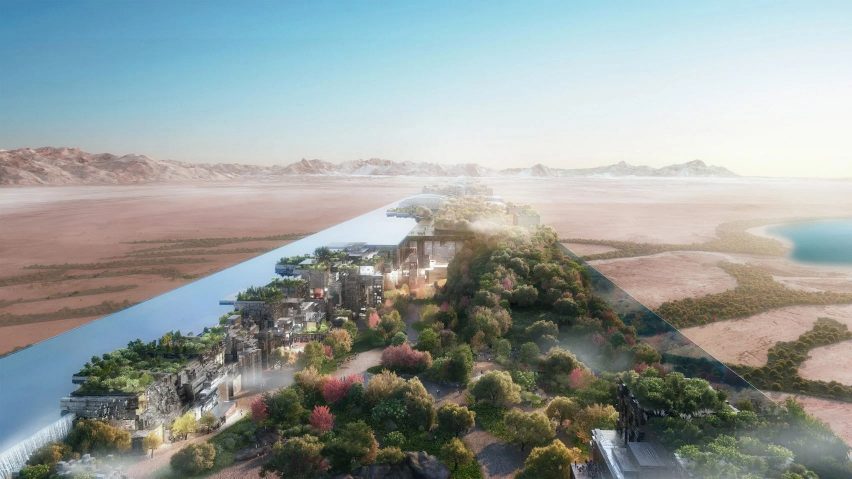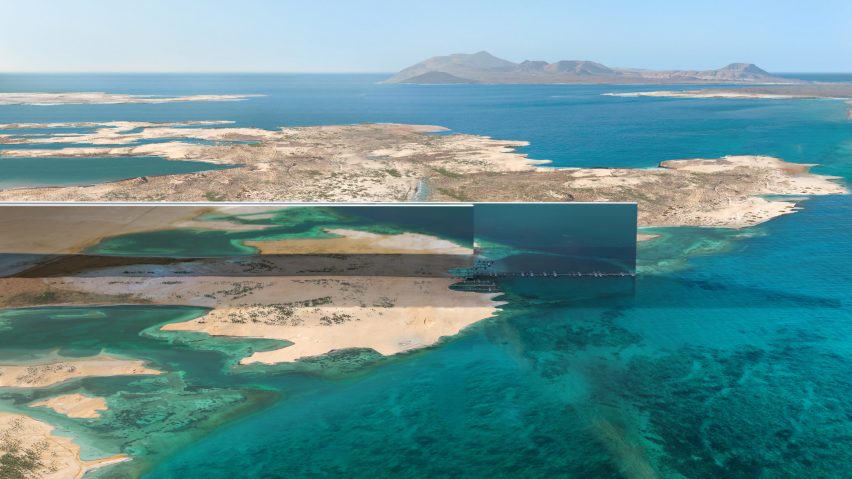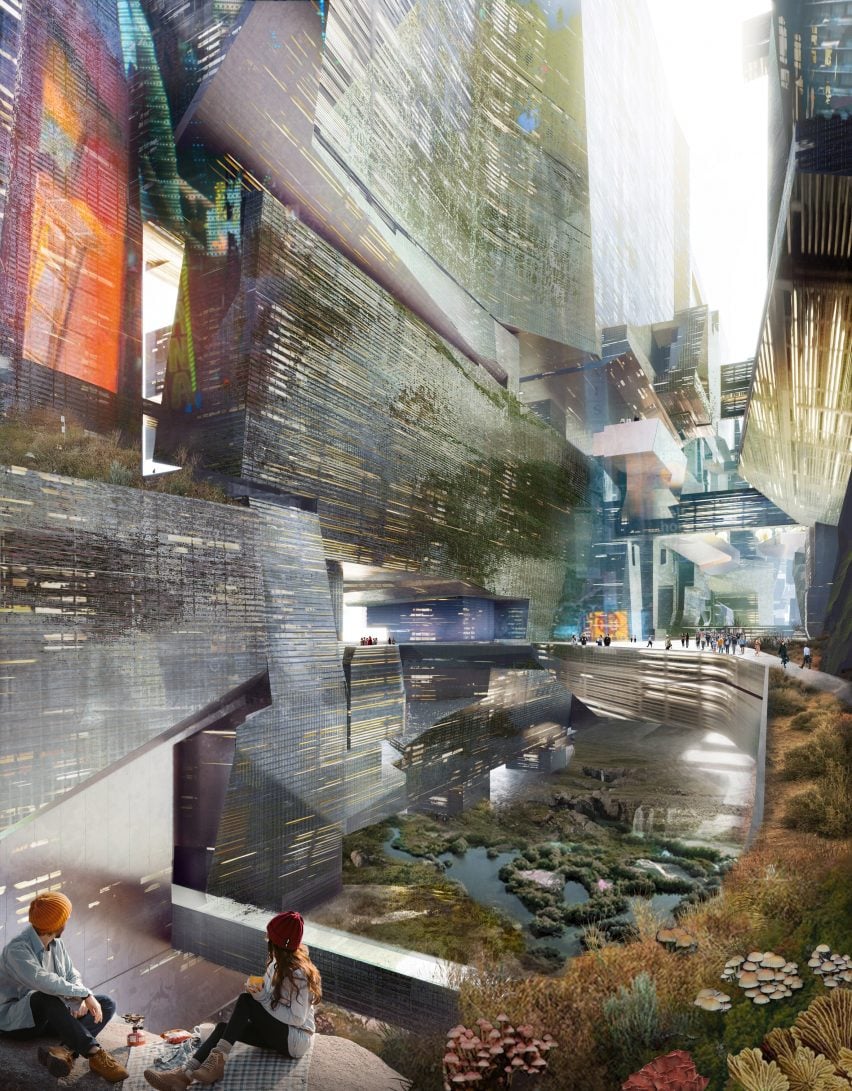
Sustainability and liveability claims of Saudi 170-kilometre city are "naive" say experts
Following the Saudi Arabian government's unveiling of plans for an enormous linear megacity in the desert, urban design experts have expressed skepticism about whether its utopian vision is realistic.
"There would be so many physical and environmental phenomena that would have to be dealt with to achieve the incredible minimal and singular character that the renderings propose," said Marshall Brown, director of the Princeton Urban Imagination Center and an associate professor of architecture at Princeton University.
Philip Oldfield, head of the built environment school at the University of New South Wales (UNSW) Sydney, warned that the huge embodied carbon cost of construction "will overwhelm any environmental benefits".
C40 Cities director of urban planning and design Hélène Chartier argued she would not "want to live in a place where it's so narrow", while architect Winy Maas said he "would love to live in such a kind of environment".

The oil-rich Middle Eastern state recently unveiled dramatic images of The Line, depicting two giant mirrored walls running straight in parallel for 170 kilometres across the desert.
Designed by US architecture studio Morphosis, it would be 500 metres tall but only 200 metres wide, with the gap in between filled by densely packed urban fabric alongside trees and plantlife and a high-speed rail network embedded underground.
Saudi crown prince Mohammed bin Salman boasted that the city, planned for nine million people, "will challenge the traditional flat, horizontal cities and create a model for nature preservation and enhanced human liveability".
Dezeen asked urban planning and design experts about how such a structure might actually work.
"It will not look like it is shown on the sketch"
"Is it feasible as a city? The challenge there is really a question of control," explained Brown.
The power of urban planning and design to determine exactly how a city gets built is limited, Brown added, particularly to the extent suggested in the visuals released by the Saudi government.
"These images project a degree of control which is very difficult to retain, especially over a period of time, even in a very autocratic society," he said.
"That is where I start to become a bit dubious. I don't mean to talk about this in a conservative way but I think there would be so many physical and environmental phenomena that would have to be dealt with to achieve the incredibly minimal and singular character that the renderings propose."
Maas, co-founder of prominent Rotterdam architecture studio MVRDV and director of cities think tank The Why Factory, is doubtful that any realised version of The Line would closely resemble the pictures.
"It will probably not look like it is shown on the sketch, for sure not, it will look like other kinds of densities," he told Dezeen. "I would not do that profile, with only two bars going straight up. That doesn't make sense in terms of variety, in terms of wind pressure, in terms of keeping cold air in."
Despite harbouring some criticisms of the design as shown in the images – the non-porosity of the outer walls, for example – Maas is positive about the overall concept.
"I love deserts and I do see the necessity to develop them and to make them so that ultimately rain comes back on those places, so I think it's crucial to work on that," he said.
"Would I mind to live there? I would love to live in such a kind of environment, when it has this kind of perspective and this message and this technical input and output, you can get me on board for making this kind of development. If this is the best place for it, if it's the best political circumstances, that's up for judgment."

C40 Cities' Chartier is less keen. "My first feeling was that it's interesting because we need a shock in urban development to endorse this idea of compactness and everything being mixed-use," she said. "But at the same time, I'm a little bit concerned that it creates some things that on paper seem interesting, but at the end is it really liveable?"
"I don't want to live there, to be honest," she added. "I don't want to live in a place where it's so narrow, there is a bit of the claustrophobic there."
In practice, the quality of life in The Line would rest heavily on its maintenance and management, according to UNSW's Oldfield, who has researched the experiences of people living in very large structures.
"Some of the internal spaces at The Line look incredibly alluring – lush atria, vast cavernous interior spaces Grand Canyon-esque in scale, with residents perched on the edge enjoying picnics," he said. "Even if these were built, the satisfaction of residents would mostly be informed by how such spaces are operated and managed, not how dramatic they look."
"What rules will be set? Can visitors use all the spaces? Which are public, which are private? Will you really be allowed to have a picnic on a ledge above a 200-metre-high atrium? Call me a cynic, but I highly doubt it."
"This would require a phenomenal quantity of steel, glass and concrete"
Brown agrees that living conditions within The Line would be largely dictated by how they are run and argues that, like in all cities, people would likely have differing levels of enjoyment depending on the resources allocated to their specific area.
"To expect that we would have a consistent experience one way or the other – the extremes being misery versus complete bliss – seems unrealistic considering it is 170 kilometres long," he said.
With the extreme compactness and absence of cars enabled by its high-rise, linear layout, plus the generous vegetation depicted in the renderings, The Line has been presented as a more sustainable alternative to conventional cities.
Its footprint would be 34 square kilometres – 46 times smaller than London's, which has a similar population size. This hyper-density would mean significantly fewer emissions from transport and less direct destruction of nature.
And Maas believes there are other aspects of the design that could be helpful from a sustainability perspective.
"The element which I find intriguing is that it's making this canyon-like space, so there could be a big temperature drop in the middle city gap," he said. "That is a technology that could be used to find ways to deal with increasing desertification."
In that sense, he added, "it puts a finger on a truly weak point of the planet".
But Oldfield is concerned about the embodied carbon impact of building The Line and all the necessary associated infrastructure, particularly considering its enormous height and the strength it would need to withstand wind loads.
"You cannot build a 500-metre-tall building out of low-carbon materials," he said. "This would require a phenomenal quantity of steel, glass and concrete."
Oldfield has estimated that building The Line would produce upwards of 1.8 billion tonnes of embodied carbon dioxide, equivalent to more than four years of the UK's entire emissions.

"My feeling is this vast embodied carbon will overwhelm any environmental benefits that a small footprint provides," he said.
"Utopian thinking is important; it helps us challenge the preconceptions in the built environment that have generated conventional outcomes which we know contribute to environmental degradation. But I think the sustainability and liveability arguments here are naive."
Oldfield and Chartier also point out that despite its small footprint, the length and nature of The Line's walls could cause biodiversity issues – including for migrating birds, for whom large mirrored structures are highly dangerous.
"In terms of biodiversity, what does it mean to create a big bar like that that cuts the environment? What does that mean for animals, how can they cross?" questioned Chartier. "We know that highways create a lot of problems."
And both argue that densifying existing cities should be the focus if we are to make more sustainable urban centres.
"Part of me thinks this may be a distraction"
"I think it's interesting to have this discussion and I don't want to criticise, but part of me thinks this may be a distraction from the real decisions we can make," said Chartier. "It's better to consolidate a good model."
The concept behind The Line is not entirely novel. Large, linear cities have been proposed multiple times in the past accompanied by similar arguments about efficiency.
As long ago as 1882, Spanish urban planner Arturo Soria y Mata was suggesting the idea of a linear city, with Soviet planner Nikolay Alexandrovich Milyutin later endorsing it in his 1930 book Sotsgorod: The Problems of Building Socialist Cities.
Architects Peter Eisenman and Michael Graves imagined a Linear City for New Jersey in 1965. Four years later, Italian firm Superstudio proposed The Continuous Monument, whose renderings bear an eerie resemblance to those for The Line.
More recently, British architect Peter Barber put forward a plan for a 160-kilometre-long, 200-metre-wide city wrapped around London.
None of these have actually been built. Corviale, a one-kilometre-long social housing block in Rome completed in 1984, perhaps comes closest to being a realised linear city.
Though the project has received significant attention, whether The Line will become reality is not yet certain.
"To even imagine what this would be like once it was completed or what would happen over time – even things like how much raw material it would require to build, how much force it would take to pump water through it from end to end, what happens to things like wind and heat at such scale – is not possible with existing comparisons," said Brown.
"We're in the realm of pure speculation, which points me back to the question of: what is this thing? I suspect the architectural image may be a provocation to instigate the conversation we are having right now."